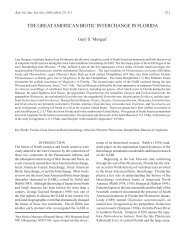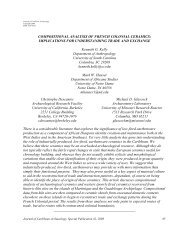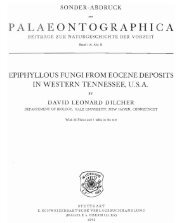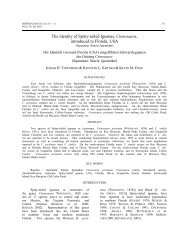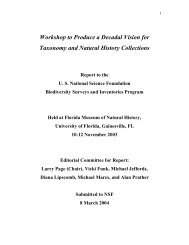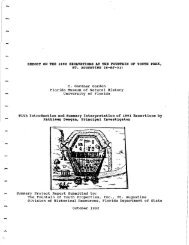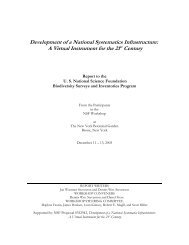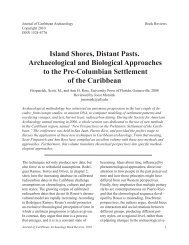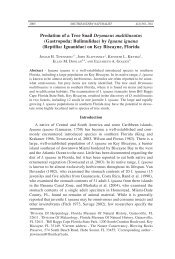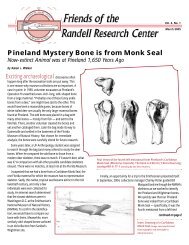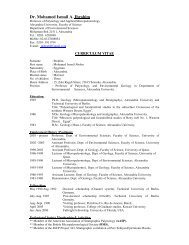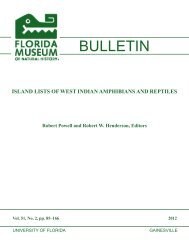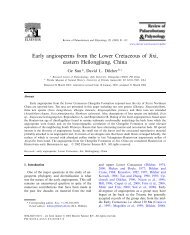Soltis Lab CTAB DNA Extraction Protocol
Soltis Lab CTAB DNA Extraction Protocol
Soltis Lab CTAB DNA Extraction Protocol
You also want an ePaper? Increase the reach of your titles
YUMPU automatically turns print PDFs into web optimized ePapers that Google loves.
<strong>Soltis</strong> <strong>Lab</strong> <strong>CTAB</strong> <strong>DNA</strong> <strong>Extraction</strong> <strong>Protocol</strong><br />
(Reference: Doyle & Doyle, 1987; and Cullings 1992)<br />
Revised November 14, 2002<br />
1. Prepare <strong>CTAB</strong> buffer, use within 2-3 days, store capped: Add polyvinylpyrrolidone<br />
(Fisher Cat#: BP431-500) and b-mercaptoethanol (Fisher Cat#: BP176-100) and stir<br />
to dissolve right before starting extractions:<br />
<strong>CTAB</strong> PVP b-merc<br />
0.5 ml 0.02g 2.5µl<br />
5 ml 0.2g 25µl<br />
20ml 0.8g 100µl<br />
2. Weigh out 10-20 mg of silica-dried plant tissue.<br />
3. Grind tissue with blue pestles<br />
a. Pestles can be reused, store in 10% bleach solution and rinse well with DI<br />
water before using them<br />
b. Grinding can be done with or without the aide of liquid nitrogen and/or<br />
washed and autoclaved sand.<br />
4. Add 500µl of <strong>CTAB</strong> buffer and grind samples a bit more.<br />
5. Incubate samples at 55˚C for 1hr to overnight.<br />
6. Add 500µl of 24:1 Chloroform :Iso Amyl Alcohol and mix well by shaking tubes.<br />
7. Centrifuge for 5-10 minutes at maximum speed.<br />
a. Following centrifugation, you should have three layers: top: aqueous phase,<br />
middle: debris and proteins, bottom: chloroform.<br />
b. Go on to the next step quickly so the phases do not remix<br />
8. Pipette off the aqueous phase taking care not to suck up any of the middle or<br />
chloroform phases. Pipetting slowly helps with this.<br />
9. Place the aqueous phase into a new labeled eppendorf tube.<br />
10. Estimate the volume of the aqueous phase.<br />
11. Add 0.08 volumes of cold 7.5 M ammonium acetate—see attached table.<br />
12. Add 0.54 volumes (using the combined volume of aqueous phase and added AmAc)<br />
of cold isopropanol (=2-propanol)—see attached table.<br />
13. Mix well.<br />
14. Let sit in freezer for 15 min to overnight.<br />
a. Longer times will tend to yield more <strong>DNA</strong>, but also more contaminants.<br />
15. Centrifuge for 3 min at maximum speed.<br />
16. Pour or pipette off the liquid, being careful not to lose the pellet with your <strong>DNA</strong>.<br />
17. Add 700µl of cold 70% Ethanol and mix<br />
18. Centrifuge for 1 min at maximum speed.<br />
19. Pour or pipette off the liquid, being careful not to lose the pellet with your <strong>DNA</strong>.<br />
20. Add 700µl of cold 95% Ethanol and mix<br />
21. Centrifuge for 1 min at maximum speed.<br />
22. Pour or pipette off the liquid, being careful not to lose the pellet with your <strong>DNA</strong>.<br />
23. Dry the pellet:<br />
a. Place samples in the speed vac for 20 min.<br />
or
. Invert samples on a Kim-wipe and let stand for 1 hr or until dry.<br />
24. Resuspend samples with 100µl of TE buffer. Allow to resuspend for 1hr at 55˚C or<br />
overnight in refrigerator before running a test gel using 5µl of the <strong>DNA</strong>.<br />
Stocks:<br />
<strong>CTAB</strong>: for 1L of <strong>CTAB</strong> buffer<br />
100 ml of 1 M Tris, pH 8.0<br />
280 ml of 5 M NaCl<br />
40 ml of 0.5 M EDTA<br />
20 g of <strong>CTAB</strong> (Cetyltrimethyl ammonium bromide, Amresco cat#:0833-1Kg)<br />
TE buffer:<br />
[Final] for 1L use:<br />
10 mM 10 ml of 1 M Tris, pH 8.0<br />
1 mM 2 ml of 0.5 M EDTA<br />
1 M Tris, pH 8.0: for 1 L<br />
121.1 g Tris (Fisher Cat#: BP152-5)<br />
700 ml ddH 2O<br />
Dissolve tris and bring to 900 ml.<br />
pH to 8.0 with concentrated HCl (will need ~50ml)<br />
Bring to 1 L.<br />
0.5 M EDTA pH 8.0: for 1 L<br />
186.12 g of EDTA (Fisher Cat#: BP120-1)<br />
750 ml ddH 2O<br />
Add about 20 g of NaOH pellets<br />
Slowly add more NaOH until pH is 8.0, EDTA will not dissolve until the pH is<br />
near 8.0.<br />
5 M NaCl: for 1 L<br />
292.2 g of NaCl (Fisher Cat#: BP358-10)<br />
700 ml ddH 2O<br />
Dissolve and bring to 1 L.<br />
Cullings, K.W. 1992. Design and testing of a plant-specific PCR primer for ecological<br />
and evolutionary studies. Molecular Ecology 1:233-240.<br />
Doyle, J.J. and J.L. Doyle. 1987. A rapid <strong>DNA</strong> isolation procedure for small quantities of<br />
fresh leaf tissue. Phytochemistry Bulletin 19:11-15.



